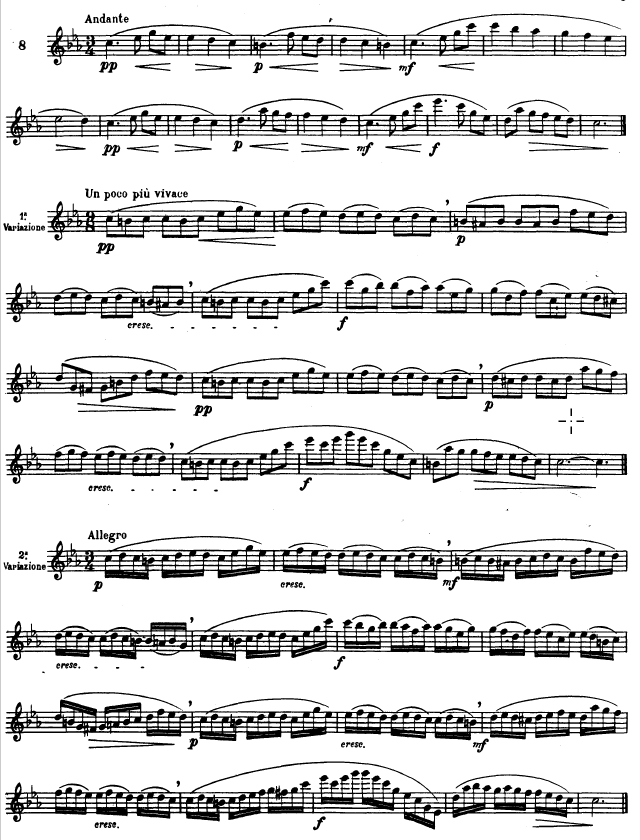Sonata in E minor
Op 167 Andante Tranquillo
by Carl Reinecke
Eileen Gilligan Flute Xinyu “Allie” Wang Piano – Undine Andante Tranquillo
Andante Tranquillo – Reinecke Sonata in Eminor Op.167 – making the most of “the space between the notes.”
Story wise this movement reflects the honeymoon and romance period of Undine and Huldbrand’s love with a fiery glimpse of Undine’ s jealousy thrown in. Musically, it is a great opportunity to explore the space between the notes. Most of the movement is the deep love and tranquil stage of their love. Undine becomes suspicious of Huldbrand in the Molto vivace section. Is there another woman and has he fallen in love with the human Bertalda? Reference Freidrich de la Motte Fouque novel “Undine” for the complete story.
The movement is an ABA basic form with a wonderful melody then Undine’s fiery outburst and a return to the opening melodic theme. In order to get it to sing and soar musically it needs space and nuance. It is up to us to decide what notes are important, where they lead and how we are going to treat them.
Debussy talked about the space between the notes.
“Music is the space between the notes“
Here is a clip of Karajan and Menuhin talking about the space between the notes:
Lao Tzi was a Chinese philosopher. His quote relating to the video was:
Thirty spokes meet in the hub,
but the empty space between them
is the essence of the wheel.
Pots are formed from clay,
but the empty space within it
is the essence of the pot.
Walls with windows and doors
form the house,
but the empty space within it
is the essence of the home.
This quote and concept will mean different things to different players. The space can be silence, a micro pause, it can be reverberation or the way we express the note value allowing the note to reach the full measure of expression. The art is in how we use that space. Choice of tone, tone colour and nuance all play into this and affect the end result of a performance. The space between the notes allows us to appreciate what we have just heard.
To me it is both tangible and intangible at the same time. It is where the deep expression happens that allows the music to have the space to sing and soar musically. The whole movement is a marvellous opportunity to explore tone, colour, expression and space.
I thought a lot about this movement before I picked up the flute to play it.
The first time it occurred to me to wonder about the space between the notes was after practising Marcel Moyse’s Melodious Studies 13 and 14. These are where we really learn to carry a phrase through “without” the space between the notes ie. maintaining intensity throughout. Players learn to hold tone colour, musical expression and intensity. This is a different look at the space between the notes. Moyse wrote these so players would not drop the air speed and colour control between notes and so maintain an intense musical line, tone and expression. This is difficult do if done properly. There is a tendency to blow through these studies without really understanding what he wanted to teach in them.

24 Little Melodic Studies No 14 written by Marcel Moyse
The weak spot for maintaining colour, quality and intensity is the middle register D’s and E’s
Here is the same thing in Melodious Study No. 8 and played by Marcel Moyse.

24 Little Melodic Studies No 8 played by Marcel Moyse
Using the voice, vocalisation and arias from practising Marcel Moyse’s Tone Development Through Interpretation also awakened the curiosity I had about the space between the notes. The voice is a unique instrument. It has an ability with elasticity that is truly wonderful and quite hard to capture on the flute.
Learning this expressive style led me to think further and be able to utilise the space between notes to give more nuance, expression and create an atmosphere.
I think this is why Moyse did not like silence between notes, hence bell tones and his passion for life in a note, phrase and opera.
Such seemingly simple little studies open a world of opportunity and musical thought. I know I would not be the player and musician I am today without having done these studies and Tone Development Through Interpretation intensely.
Here is William Bennett – Wonderful example of the space between the notes.
Why would a player want to spend time on these studies and Tone Development Through Interpretation? To be able to control a melodic line exactly as one wants with nuance and colour is why. This movement and a player’s artistry will reap the rewards of the time put into them by the player.
This is why practising studies and etudes endlessly can be destructive musically unless there is a clear musical goal in the practice structure. The player can turn into a “finger wiggler” that just plays the notes if there is not a musical outcome with everything one performs. Balance and identifying the underlying beauty of the music or etude is at the core of everything.
There is space in everything we play, it is how we use it that makes the difference.
Carl Reinecke Undine Sheet Music
Download a copy of the sheet music.

Recent Comments